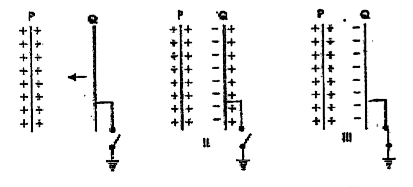What is capacitor? Explain its principle.Solution in Punjabi
Principle of a Capacitor : Capacitance of a charged conductor is appreciably increased by bringing another uncharged or low potential conductor connected to earth near it, provided two conductors remain separated with some non-conducting medium in-between.
Consider a positively charged conducting plate A in air. Bring an uncharged conducting plate Q closer to plate P (Fig. 1) such that negative charge is induced on nearer face of plate Q and equal positive charge on the farther face of plate Q.
The induced negative charge on plate Q tends to decrease the potential of plate P {because -ve charge on Q tries to cancel the effect of +ve charge on P), while the induced positive charge on plate Q tends to increase the potential of plate P. Since induced negative charge of Q is closer to plate P than the induced positive charge, so there will be net decrease in the potential of plate P (Fig. II). In order to make the potential of the plate P same, more charge can be given to it. It is clear that capacity of plate P has increased by bringing an uncharged conducting plate Q closer to it.
If plate Q is now connected to the earth (Figt III) induced positive charge will be neutralized by the electrons coming from earth. Potential of plate P is further decreased as now there is only induced negative charge on plate Q. In order to make the potential of the plate P same, more charge can be given to it. Thus, a large amount of charge can be stored in the above arrangement.

A system of formed (Fig. Ill) is called a parallel plate capacitor. Thus, to store charge, a potential difference. is required between the conducting plates separated by some nonconducting medium.
Topper's Solved these Questions
- CAPACITANCE BOOK - BETTER CHOICE PUBLICATIONCHAPTER - CAPACITANCE EXERCISE - LONG ANSWERTYPE QUESTIONS (5/6 Marks Questions)
16 Videos
- CAPACITANCE BOOK - BETTER CHOICE PUBLICATIONCHAPTER - CAPACITANCE EXERCISE - NUMERICAL PROBLEMS
21 Videos
- CAPACITANCE BOOK - BETTER CHOICE PUBLICATIONCHAPTER - CAPACITANCE EXERCISE - SHORT ANSWERTYPE QUESTIONS (2 Marks Questions)
5 Videos
- ALTERNATING CURRENTS BOOK - BETTER CHOICE PUBLICATIONCHAPTER - ALTERNATING CURRENTS EXERCISE - MOST EXPECTED QUESTIONS
11 Videos
- CLASSIFICATION OF MATERIALSBOOK - BETTER CHOICE PUBLICATIONCHAPTER - CLASSIFICATION OF MATERIALSEXERCISE - Most expected question (2 marks)
3 Videos
Similar Questions
Derive an expression for capacitance of a parallel plate capacitor.
View SolutionA parallel plate capacitor with air between the plates has a capacitance of 8 pF. The separation between the plates is now reduced by half and the space between them is filled with a medium of dielectric constant K. Calculate the value of the capacitance of the capacitor in the second case.
View SolutionFind an expression for the capacity of a metallic sphere.
View SolutionWhat is a phasor?
View SolutionDoes the magnetisation of a paramagnetic salt dependon temperature ? Give reason for your answer.
View Solutionसंधारित्र का सिद्धान्त समझाइए |
View Solutionशण्ट किसे कहते है ? इसका सिद्धांत समझाइये ।
View Solutionट्रान्सफॉर्मर क्या है ? इसका सिद्धान्त समझाइए ।
View Solutionप्रकाश मॉडुलन क्या है ? इसके सिद्धांत बताइए ।
View Solutionसंधारित्र का सिद्धांत क्या है? समझाइये। समांतर प्लेट संधारित्र की धारिता हेतु व्यंजक प्राप्त कीजिए।
View Solutionएक संधारित्र क्या होता है? इसमें निहित सिद्धांत को समझाएँ।
View Solutionट्रांसफॉर्मर क्या है? इसका सिद्धान्त समझाइए।
View Solutionदौलित्र क्या है ? इसका सिद्धान्त समझाइए।
View Solutionसंधारित्र किसे कहते है। इसका सिध्दान्त समझाइए। किसी संधारित्र की धारिता की परिभाषा एवं मात्रक लिखिए।
View Solutionसंधारित्र किसे कहते है ? इसके सिद्धांत को समझाइए | संधारित्रों के समांतर क्रम तथा श्रेणीक्रम में संयोजन के लिए सूत्र ज्ञात कीजिए |
View SolutionWhat is atomic hydrogen torch? Explain its principle.
View Solution
